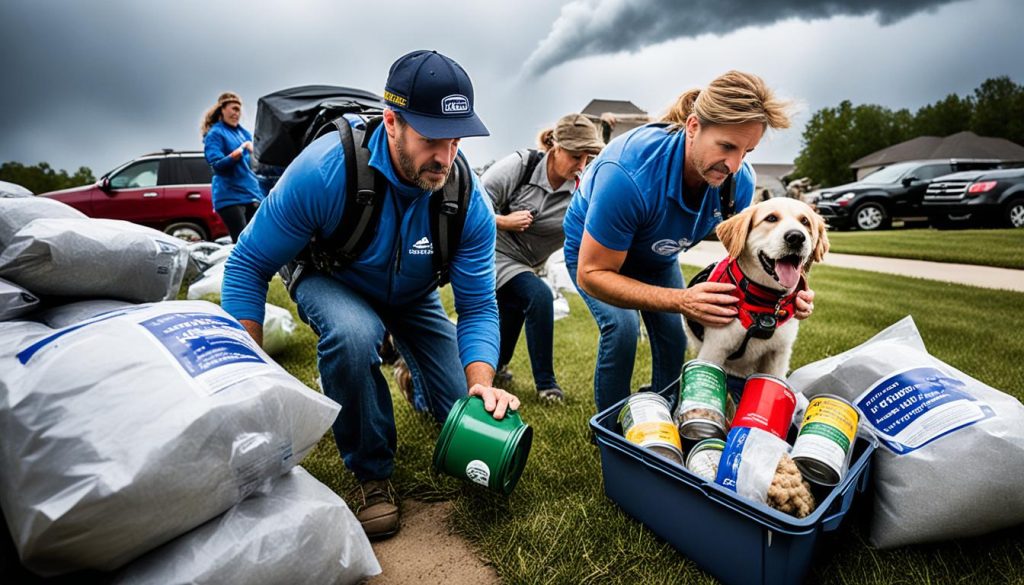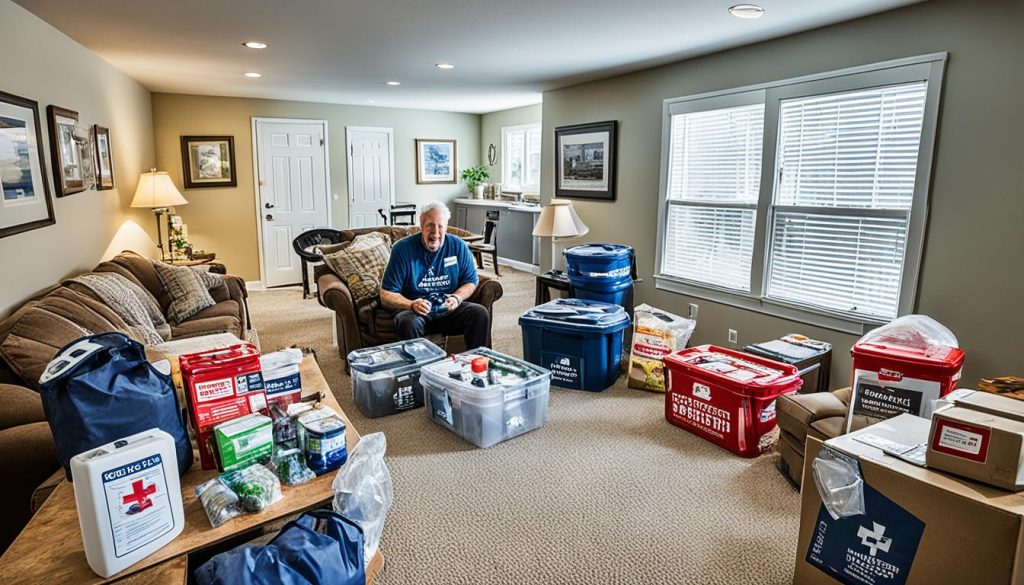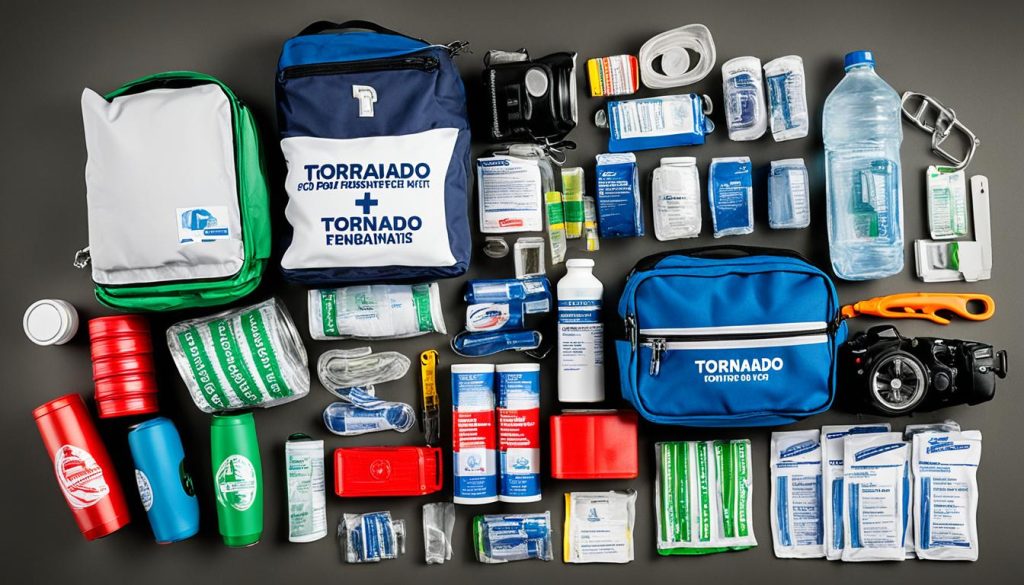Did you know that tornadoes can reach wind speeds of up to 300 miles per hour? That’s more powerful than a Category 5 hurricane! With the potential for such devastation, it’s crucial to be prepared for tornadoes and take the necessary safety precautions to protect yourself and your loved ones.
In this article, we will provide you with essential tornado safety tips and guide you on how to create a tornado emergency kit. By following these guidelines, you can be better prepared to handle the worst-case scenario and navigate through a tornado with confidence.
Key Takeaways:
- Being prepared is essential when it comes to tornado safety.
- Creating a written tornado preparedness plan and conducting regular drills are crucial steps.
- Identify a designated shelter area and stock it with necessary supplies.
- Learn and educate others on safety precautions during a tornado.
- Stay informed about tornado warnings and identify safe locations for evacuation.
Designating a Shelter Area and Supplies
When a tornado warning is issued, it’s crucial to designate a safe location to meet in your home or facility. The ideal choice is a basement or tornado shelter, as they provide the highest level of protection. However, if these options are not available, you can choose an interior room or hallway on the lowest level of your building.
Creating a disaster survival kit is also essential for tornado preparedness. This kit should include a variety of items to help you and your loved ones stay safe during a tornado emergency. Some key supplies to include are:
- A whistle to signal for help
- Flashlights with extra batteries
- A portable weather radio to stay informed about severe weather conditions
- Non-perishable food items and bottled water
- A first aid kit
- Extra clothing and blankets
- Important documents such as identification papers and insurance information
In addition to having the necessary supplies, it’s crucial to ensure that everyone in your household or facility knows the fastest route to the designated shelter area. This can be achieved through regular tornado drills. By practicing these drills, you’ll be better prepared to navigate to safety quickly and efficiently when a tornado strikes.
Safety Precautions during a Tornado
When a tornado strikes, it’s crucial to know the proper safety precautions to protect yourself and your loved ones. By following these guidelines, you can increase your chances of staying safe during this severe weather event.
- Tornado Safety Precautions: Crouch down low and cover your head to minimize the risk of injury from flying debris. Seek shelter under large, sturdy objects or in interior rooms with no windows for extra protection.
- Stocking Your Shelter Area: Prepare your designated shelter area by stocking it with mattresses or sleeping bags. These can provide additional cover and help to shield you from falling debris.
Expert Insight: “Having a designated shelter area and stockpiling essential supplies can significantly increase your chances of surviving a tornado unharmed.” – Dr. Emily Johnson, Meteorologist
Familiarize yourself with the warning signs of an approaching tornado:
- Tornado Warning Signs:
- A dark, greenish sky
- Heavy rain followed by intense winds
- A rotating wall cloud
- A loud roaring sound
By recognizing these warning signs, you can take immediate action and seek shelter before the tornado hits. Remember to stay informed about tornado warnings by monitoring local weather reports and alerts.
Practice Tornado Drills to Ensure Preparedness
Tornado drills are an essential aspect of tornado safety preparedness. By regularly practicing these drills, you can ensure that everyone in your household or facility knows the fastest route to the designated shelter area.
During a tornado drill, simulate the actions you would take during an actual tornado. Crouch down low, cover your head, and seek shelter in the designated area. Use this opportunity to identify any potential hazards or obstacles that may impede your evacuation and make necessary adjustments.
Remember, proper preparation and readiness are key to protecting yourself and your loved ones during a tornado. By following safety precautions, stocking your shelter area, and practicing tornado drills, you can increase your chances of staying safe in the face of this powerful natural disaster.
Evacuation and Safe Locations
When it comes to tornado safety, having a solid evacuation plan and knowing the location of safe shelters are crucial. While a basement or safe room is the ideal option, not everyone has access to these resources. In such cases, it’s important to identify an interior, windowless room or closet on the lowest level of your home as your shelter location. This will provide the highest level of protection from the destructive forces of a tornado.
During a tornado, it is essential to seek shelter away from windows and heavy objects. These can pose a significant risk of injury or even fatality in the event of high winds and flying debris. Instead, find a small, enclosed space where you can hunker down until the danger passes.
While seeking shelter, it’s important to remember that automobiles and mobile homes are not safe options during a tornado. The high winds and intense forces can easily overturn or destroy these structures. It is always best to find a sturdy building or structure to seek refuge until the storm subsides.
If you find yourself away from home when a tornado warning is issued, be sure to know where to go for safety. Familiarize yourself with public buildings, community centers, or storm shelters that are designated as safe locations during tornado events.
For those who want to take extra precautions, consider building a reinforced safe room or storm cellar in your home. These structures are designed to withstand the intense forces of a tornado and provide optimal protection for you and your loved ones. Consult with professionals who specialize in tornado shelter construction to ensure the highest level of safety.
Tornado Emergency Supplies
Preparing for a tornado emergency requires having essential supplies readily available. Creating an emergency kit with the necessary items can make all the difference in ensuring the safety and well-being of you and your loved ones.
Home Emergency Kit
When assembling your tornado emergency kit, include the following items:
- Non-perishable food: Stock up on canned goods, energy bars, and other non-perishable food items that can sustain you for at least three days.
- Water: Store one gallon of water per person per day, ensuring you have enough for both drinking and sanitation purposes.
- Manual can opener: Make sure you have a manual can opener on hand to access canned food.
- Flashlights and batteries: Keep multiple flashlights and extra batteries in your kit to provide light during power outages.
- Battery-operated weather radio: Stay informed about severe weather conditions by having a battery-operated weather radio in your kit.
- First aid kit: Include a well-stocked first aid kit that can address minor injuries and medical needs.
- Cash: Have some cash on hand in case electronic payment systems are unavailable.
- Tarps and basic tools: Include tarps, duct tape, and basic tools like a wrench and pliers for any necessary repairs.
- Copies of important documents: Keep copies of essential documents, such as identification papers and insurance policies, in a waterproof, portable container.
Car Emergency Kit
Don’t forget to have supplies in your vehicle that can aid you during a tornado emergency:
- Jumper cables: Keep jumper cables in your car to assist with battery-related issues.
- Reflective triangles: Use reflective triangles to provide visibility and warn others in case of a roadside emergency.
- Non-perishable snacks and water: Pack non-perishable snacks and extra water for sustenance while on the road.
- Shovel: Include a shovel to help clear debris or provide traction on slippery surfaces.
- Cat litter: Use cat litter for extra traction if your vehicle gets stuck.
- Blankets: Keep blankets in your car to provide warmth during unexpected stops or delays.
Remember to carry a mini flashlight, cell phone, extra cash, pocket knife, and lighter with you during tornado season to be prepared for any emergency situation.
By having a well-stocked tornado emergency kit both at home and in your vehicle, you can ensure that you are equipped to face unexpected tornadoes and protect yourself and your loved ones.
| Home Emergency Kit | Car Emergency Kit |
|---|---|
| Non-perishable food | Jumper cables |
| Water | Reflective triangles |
| Manual can opener | Non-perishable snacks and water |
| Flashlights and batteries | Shovel |
| Battery-operated weather radio | Cat litter |
| First aid kit | Blankets |
| Cash | |
| Tarps and basic tools | |
| Copies of important documents |
Conclusion
Tornadoes are destructive forces of nature that require thorough preparation and protective measures. Having a written plan, conducting tornado drills, and stocking emergency supplies are crucial for tornado safety preparedness. By being prepared, you can increase your chances of staying safe during these severe storms.
Identifying safe locations, practicing evacuation plans, and staying informed about tornado warnings are key components of a tornado survival guide. Understanding the signs of an approaching tornado and taking appropriate safety precautions can help minimize the risk of harm to you and your loved ones.
Remember, tornadoes can strike with little or no warning. It is essential to prioritize tornado safety preparedness by designating a shelter area, creating an emergency kit, and staying updated with the latest weather information. Taking these steps can make a significant difference in your ability to ride out a tornado safely.



